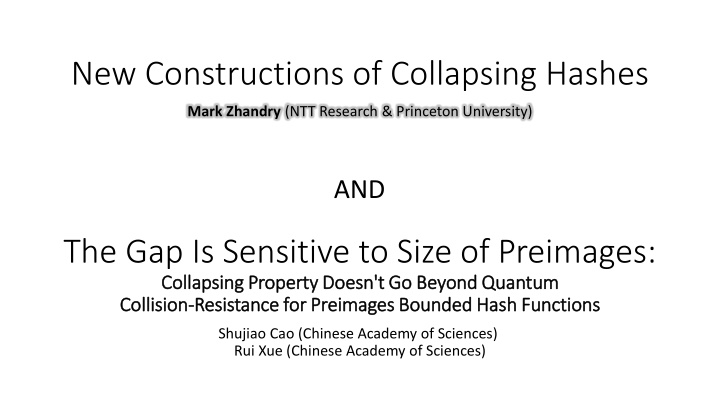
New Constructions of Collapsing Hashes - Quantum Security Insights
Discover the latest insights into quantum security regarding collapsing hash functions, preimage-bound hash functions, classical collision resistance, post-quantum collision resistance, and more. Explore the implications of collapsing property and its importance in post-quantum hashing security.
Download Presentation

Please find below an Image/Link to download the presentation.
The content on the website is provided AS IS for your information and personal use only. It may not be sold, licensed, or shared on other websites without obtaining consent from the author. If you encounter any issues during the download, it is possible that the publisher has removed the file from their server.
You are allowed to download the files provided on this website for personal or commercial use, subject to the condition that they are used lawfully. All files are the property of their respective owners.
The content on the website is provided AS IS for your information and personal use only. It may not be sold, licensed, or shared on other websites without obtaining consent from the author.
E N D
Presentation Transcript
New Constructions of Collapsing Hashes Mark Zhandry (NTT Research & Princeton University) AND The Gap Is Sensitive to Size of Preimages: Collapsing Property Doesn't Go Beyond Quantum Collapsing Property Doesn't Go Beyond Quantum Collision Collision- -Resistance for Preimages Bounded Hash Functions Resistance for Preimages Bounded Hash Functions Shujiao Cao (Chinese Academy of Sciences) Rui Xue (Chinese Academy of Sciences)
Classical Collision Resistance H x1 x2 Pr[ ]< negl H(x1)=H(x2)
Q: What security should hash functions satisfy when adversary is quantum?
Post-Quantum Collision Resistance H x1 x2 Pr[ ]< negl H(x1)=H(x2)
Thm [Ambainis-Rosmanis-Unruh14,Unruh16a]: PQ-CRHF that is not binding as a commitment (relative to an oracle) c m r s.t. c = H(m,r) Where s the collision? Classically, generate collision via rewinding. Rewinding problematic quantumly
Def[Unruh16a]: Collapsing c x x x x x H(x) Intuition: if H were injective, measuring x and H(x) both fully collapse input state. Collapsing says compressing H as good as injective Now widely regarded as right notion of security for post-quantum hashing
What was previously known? Thm[Unruh 16a]: Random oracles are collapsing Thm[Unruh 16b, Liu-Z 19]: LWE Lossiness Collapsing Thm [Z 19]: Non-collapsing PQ-CRHF quantum lightning/money (notoriously hard to construct) Thm [Ambainis-Rosmanis-Unruh 14, Unruh 16a]: non-collapsing CRHF relative to oracle
Extreme 1: All standard-model PQ-CRHFs are collapsing? Frustratingly wide gap Extreme 2: Only standard- model collapsing hashes are LWE/lossy based?
Results of Cao-Xue22 (concurrent and independent) Thm [Cao-Xue 22]: collapsing hashes assuming an almost regular PQ-CRHFH (even if H itself is not collapsing) Cor [Cao-Xue 22]: collapsing hashes assuming SIS is quantum hard Note: SIS LWE [Regev 05] collapsing hashes [Unruh 16b] SIS itself is collapsing if modulus super-poly, assuming LWE [Liu-Z 19] But [Cao-Xue 22] fundamentally different since no lossiness!
Results of Z22 (concurrent and independent) Thm [Z 22]: collapsing hashes assuming any one of the following: A semi-regular PQ-CRHF (major relaxation of almost regular ) Quantum hardness of LPN in essentially same parameter regimes known to imply classical collision resistance Quantum hardness of finding short cycles in exponentially large expander graphs (e.g. isogenies over elliptic curves) An optimallysecure PQ-CRHF (no regularity assumed) Trivial Cor: PQ Statistically hiding commitments and succinct arguments under any of the above assumptions
Starting point of both works Thm [Cao-Xue 22, Z 22]: If H is a PQ-CRHF and is poly-to-1, then H is collapsing
Proof: Measure x, apply distinguisher, then measure x again collision with non-negligible probability Ex: 2-to-1 Distinguishing advantage bases far apart x1,x2: colliding inputs |b1 , |b2 : basis for distinguisher
Extension Thm [Cao-Xue 22]: If H is a PQ-CRHF and is almost regular, then collapsing H built from H Thm [Z 22]: If H is a PQ-CRHF and is semi-regular, then collapsing H built from H Almost/semi-regular: worst-case number of pre-images not too far from expected
Proof (Z22): bits m1 m4 m3 m2 H H H H f f f f IV k-wise independent Idea: poly-to-1 on image of previous step
Proof (Z22): m1 m2 0 0 H H H H f1 f2 f3 f4 IV Technicalities
SIS hash function [Ajtai 96] A x x short Thm [Cao-Xue 22]: SIS is almost regular in many parameter settings
LPN hashing [Brakerski-Lyubashevsky-Vaikuntanathan-Wichs 19, Yu-Zhang-Weng-Guo-Li 19] A x x sparse Thm [Z 22]: LPN hashing is semi-regular in many parameter settings
Expander-based hashing [Charles-Lauter-Goren 07] Exponentially large Thm [Alon-Benjamini-Lubetzky-Sodin 07]: Non-backtracking walks on expanders mix Cor [Z 22]: Expander hashing is semi-regular
Optimal Collision Resistance Def: H:{0,1}m {0,1}nis optimally (PQ) collision resistant if Pr[A outputs collision] poly/2n Thm [Z 22]: If m < n+O(log n) and H is optimally PQ C.R., then H is collapsing Proof: Optimal C.R. hard to find x that collides with with super-poly values collapsing by poly-to-1 case
Takeaway: Collapsing is perhaps more prevalent than previously thought Thanks!






















